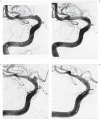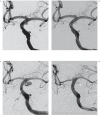The efficacy of endovascular treatment of ruptured blood blister-like aneurysms using stent-assisted coil embolization
- PMID: 23217638
- PMCID: PMC3520557
- DOI: 10.1177/159101991201800409
The efficacy of endovascular treatment of ruptured blood blister-like aneurysms using stent-assisted coil embolization
Abstract
We report our experience with endovascular treatment and follow-up results of a ruptured blood blister-like aneurysm (BBA) in the supraclinoid internal carotid artery. We performed a retrospective review of ruptured blood blister-like aneurysm patients over a 30-month period. Seven patients (men/women, 2/5; mean age, 45.6 years) with ruptured BBAs were included from two different institutions. The angiographic findings, treatment strategies, and the clinical (modified Rankin Scale) and angiographic outcomes were retrospectively analyzed. All seven BBAs were located in the supraclinoid internal carotid artery. Four of them were ≥ 3 mm in largest diameter. Primary stent-assisted coiling was performed in six out of seven patients, and double stenting was done in one patient. In four patients, the coiling was augmented by overlapping stent insertion. Two patients experienced early re-hemorrhage, including one major fatal SAH. Complementary treatment was required in two patients, including coil embolization and covered-stent placement, respectively. Six of the seven BBAs showed complete or progressive occlusion at the time of late angiographic follow-up. The clinical midterm outcome was good (mRS scores, 0 -1) in five patients. Stent-assisted coiling of a ruptured BBA is technically challenging but can be done with good midterm results. However, as early re-growth/re-rupture remains a problem, repeated, short-term angiographic follow-up is required so that additional treatment can be performed as needed.
Figures




Similar articles
-
Endovascular treatment using predominantly stent-assisted coil embolization and antiplatelet and anticoagulation management of ruptured blood blister-like aneurysms.AJNR Am J Neuroradiol. 2011 Apr;32(4):764-71. doi: 10.3174/ajnr.A2392. Epub 2011 Mar 3. AJNR Am J Neuroradiol. 2011. PMID: 21372169 Free PMC article.
-
Reconstructive endovascular treatment of ruptured blood blister-like aneurysms of the internal carotid artery.J Neurosurg. 2009 Mar;110(3):431-6. doi: 10.3171/2008.7.JNS08257. J Neurosurg. 2009. PMID: 19046039
-
Endovascular treatment of ruptured blood blister-like aneurysms with multiple (≥3) overlapping Enterprise stents and coiling.Acta Neurochir (Wien). 2016 Apr;158(4):803-809. doi: 10.1007/s00701-016-2721-8. Epub 2016 Feb 9. Acta Neurochir (Wien). 2016. PMID: 26858206
-
Treatment of ruptured blood blister aneurysms using primary flow-diverter stenting with considerations for adjunctive coiling: A single-centre experience and literature review.Interv Neuroradiol. 2017 Oct;23(5):465-476. doi: 10.1177/1591019917720805. Epub 2017 Jul 31. Interv Neuroradiol. 2017. PMID: 28758550 Free PMC article. Review.
-
Endovascular coil embolization for saccular-shaped blood blister-like aneurysms of the internal carotid artery.Acta Neurochir (Wien). 2011 Feb;153(2):287-94. doi: 10.1007/s00701-010-0898-9. Epub 2010 Dec 7. Acta Neurochir (Wien). 2011. PMID: 21136276 Review.
Cited by
-
Blister-like aneurysms of middle cerebral artery: a multicenter retrospective review of diagnosis and treatment in three patients.Neurosurg Rev. 2015 Jan;38(1):197-202; discussion 202-3. doi: 10.1007/s10143-014-0581-3. Epub 2014 Oct 18. Neurosurg Rev. 2015. PMID: 25323097
-
Application of the Willis covered stent in the treatment of internal carotid artery blood blister-like aneurysms.Neurosurg Rev. 2022 Apr;45(2):1513-1519. doi: 10.1007/s10143-021-01666-3. Epub 2021 Oct 18. Neurosurg Rev. 2022. PMID: 34657974
-
The formation mechanism of acute dissection of blood blister-like aneurysm and its implication of endovascular treatment.Chin Neurosurg J. 2021 Jun 3;7(1):32. doi: 10.1186/s41016-021-00245-1. Chin Neurosurg J. 2021. PMID: 34078466 Free PMC article.
-
Endovascular Treatment of Ruptured Intracranial Blister Aneurysms: A Systematic Review and Meta-analysis.AJNR Am J Neuroradiol. 2021 Mar;42(3):538-545. doi: 10.3174/ajnr.A6924. Epub 2020 Dec 24. AJNR Am J Neuroradiol. 2021. PMID: 33361375 Free PMC article.
-
Current status of the treatment of blood blister-like aneurysms of the supraclinoid internal carotid artery: A review.Int J Med Sci. 2017 Apr 8;14(4):390-402. doi: 10.7150/ijms.17979. eCollection 2017. Int J Med Sci. 2017. PMID: 28553172 Free PMC article. Review.
References
-
- Abe M, Tabuchi K, Yokoyama H, et al. Blood blister-like aneurysms of the internal carotid artery. J Neurosurg. 1998;89:419–424. - PubMed
-
- Ogawa A, Suzuki M, Ogasawara K. Aneurysms at nonbranching sites in the supraclinoid portion of the internal carotid artery: internal carotid artery trunk aneurysms. Neurosurgery. 2000;47:578–586. - PubMed
-
- Sim SY, Shin YS, Cho KG, et al. Blood blister-like aneurysms at nonbranching sites of the internal carotid artery. J Neurosurg. 2006;105:400–405. - PubMed
-
- Meling TR, Sorteberg A, Bakke SJ, et al. Blood blister-like aneurysms of the internal carotid artery trunk causing subarachnoid hemorrhage: treatment and outcome. J Neurosurg. 2008;108:662–671. - PubMed
-
- Yanagisawa T, Mizoi K, Sugawara T, et al. Direct repair of a blisterlike aneurysm on the internal carotid artery with vascular closure stable clips: technical note. J Neurosurg. 2004;100:146–149. - PubMed
MeSH terms
LinkOut - more resources
Full Text Sources
Medical

